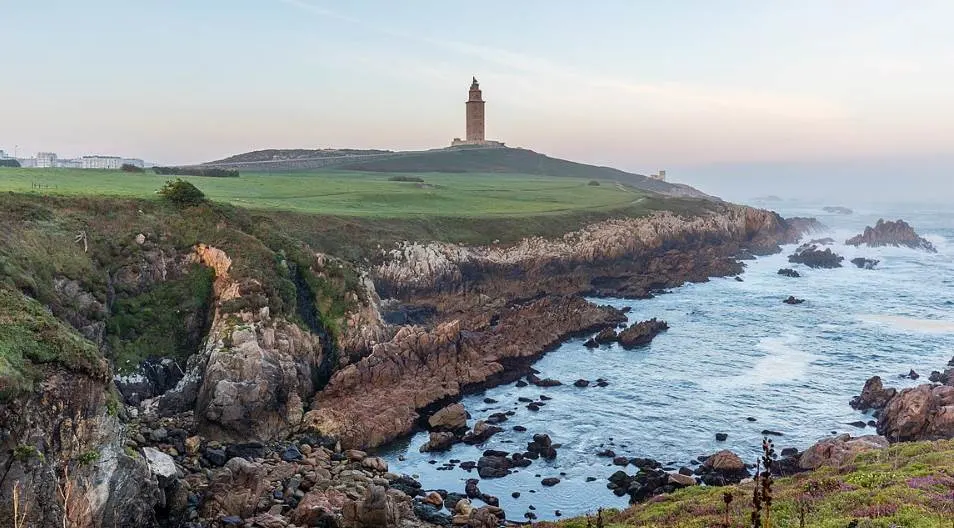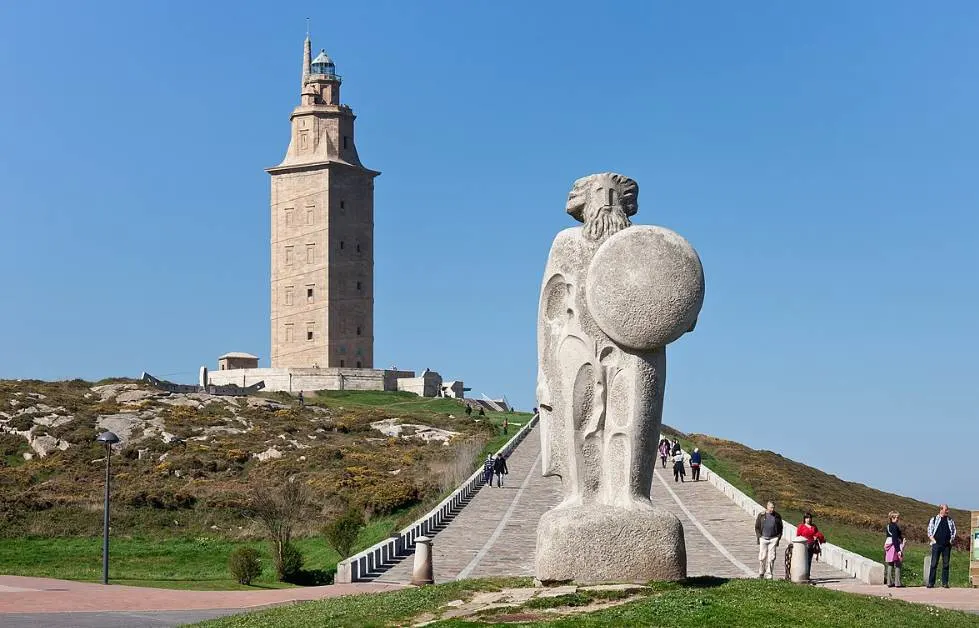The oldest extant lighthouse in the world has a history that goes back 2 millennia.
It was constructed by the Romans and it gives us a great insight into how amazing lighthouses were erected in ancient times.
In this article, we’ll take a closer look at some of the most interesting facts about the Tower of Hercules, one of the most fascinating monuments in Spain.
1. It’s located in the utmost northwestern corner of Spain
The Tower of Hercules is an incredible monument in Galicia, the utmost northwestern region of Spain.
It’s situated on a peninsula just north of the city of A Coruña, the most populous city in Galicia with a population of over 430,000 inhabitants in its metropolitan area.
The monumental tower stands just 2.4 kilometers (1.5 miles) from the city center of A Coruña.
It’s situated in a somewhat desolate area on the relatively small peninsula and majestically overlooks the Atlantic Ocean.

2. The original version of the lighthouse was constructed in the 1st century A.D.
It’s believed that a lighthouse already existed here since the 1st century A.D. It’s possible that it was constructed by Roman Emperor Trajan who ruled between 98 and 117 A.D.
It’s very likely that an even older structure already existed here and that the lighthouse was constructed on the foundations of a Phoenician building.

The strategic location of this peninsula that overlooks the Atlantic Ocean had surely been recognized already.
The Romans believed Galicia to be the end of the Earth, a notion emphasized by the fact that they called it “Finisterra.”
Because of the copious amounts of shipwrecks here, it is also notoriously referred to as the “Costa da Morte” or the “Coast of Death.”

3. The tower had a different name until the 20th century
The city of A Corunña was known as “Brigantia” in Roman times. This was a reference to the Brigantes, a Celtic tribe that lived in this region.
The lighthouse was named “Farum Brigantium” ad remarkably kept this name until the 20ty century.
The name “Farum” is a reference to the word “Pharos,” the Greek word that was used to describe the Lighthouse of Alexandria, one of the 7 Wonders of the Ancient World that was destroyed by a series of earthquakes.
The current name was derived from a myth in which the hero Hercules defeated the giant tyrant Geryon. He ordered a city to be constructed here known today as A Coruña and the lighthouse was constructed on top of the buried tyrant.

4. The tower was completely renovated in the late-18th century
The base of the ancient lighthouse still stood 34 meters (112 feet) tall in the late 18th century. The structure had, however, become so dilapidated that a serious renovation effort was required.
The tower was completely renovated in the contemporary Neoclassical architectural style in a project that was completed between 1789 and 1792.
It was naval engineer Eustaquio Giannini who completed the work during the reign of King Charles III of Spain.

5. How tall is the Tower of Hercules?
The base of the ancient tower was retained but the core Roman structure was completely repaired. This includes the technical functions needed to ensure the lighthouse remains operational.
Because of this successful project, the lighthouse has been continuously operational since the 2nd century A.D., making it the oldest operational lighthouse in the world.
A fourth story was added to the structure which has a height of 21 meters (69 feet). This addition makes it still the second-tallest lighthouse in Spain after the Chipiona Lighthouse in Cádiz which stands 62 meters (205 feet) tall.
The Tower of Hercules has a total height of 56.8 meters (185 feet) tall. Because it was constructed in an elevated location it looks a lot taller than that.

6. The ancient version was both shorter and wider than the current tower
The fourth story that added over 20 meters to the tower’s height wasn’t present in ancient times so it was significantly shorter back then.
One of the most fascinating facts about the Tower of Hercules is that it was also much wider back then. That’s because it featured a ramp that allowed people to travel to the top by horse.
The remains of this ramp can still be seen on the exterior of the tower today.

7. Visitors are welcomed by a large statue of a legendary Celtic King
This magnificent monument has become a popular tourist attraction in A Coruña.
To make the lighthouse even more attractive, a sculptural garden with a nice road leading up to the tower has been constructed.
Visitors are welcomed by a huge sculpture of King Breogán, the legendary founding father of the Celtic Galician Nation.
According to an 11th-century Irish book called “Lebor Gabála Érenn or “the “Book of Invasions,” this king constructed a huge tower and could see the green shore of Ireland in the distance.
The legend claims that he sailed to Ireland and his descendants stayed in Ireland and are the Celtic ancestors of the current Irish people.

8. It was declared a National Monument of Spain and a UNESCO site
The extensive history of the lighthouse, its remarkable architecture, and the successful Neoclassical renovation project, has earned it two prestigious dedications.
The tower became a National Monument of Spain in 1931 and was inscribed as a UNESCO World Heritage site in 2009.
It’s the only fully preserved Roman lighthouse that still functions for maritime signaling today. This alone makes it one of the most fascinating landmarks in Spain.

